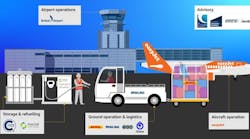An aviation hydrogen handling and refueling project, led by Airbus and supported by academic partners, airport operators and leading hydrogen-industry companies, aims to demonstrate small-scale liquid hydrogen aircraft ground operations at three European airports.
The urge to decarbonize the economy and to develop Europe’s energy independence is leading to a major trend of hydrogen for mobility and stationary applications. Hydrogen will also be a solution to decarbonise short- and medium-haul aviation and will be crucial for the advancement of low-carbon aviation operations.
What's GOLIAT?
GOLIAT is funded by the European Union (EU).
“The GOLIAT (Ground Operations of LIquid hydrogen AircrafT) project will receive funding of €10.8 million from the EU’s Horizon Europe Framework Programme via CINEA, the European Climate, Infrastructure and Environment Executive Agency. The project duration is four years and it will demonstrate how high-flow liquid hydrogen (LH2) handling and refuelling technologies can be developed and used safely and reliably for airport operations.
The GOLIAT consortium consists of 10 partners from eight countries: Airbus (France, Germany, UK), Chart Industries (Czech Republic, Italy), TU Delft (Netherlands), Leibniz University Hannover (Germany), Royal Schiphol Group (Netherlands), Rotterdam The Hague Airport (Netherlands), Vinci Airports (France, Portugal), Stuttgart Airport (Germany), H2FLY (Germany), and Budapest Airport (Hungary).
What are the goals of the group?
The group will support the aviation industry’s adoption of LH2 transportation and energy storage solutions by:
- Developing and demonstrating LH2 refueling technologies scaled-up for future large commercial aircraft;
- Demonstrating small-scale LH2 aircraft ground operations at airports;
- Developing the standardzsation and certification framework for future LH2 operations;
- Assessing the sizing and economics of the hydrogen value chains for airports.
As a clean and efficient fuel, LH2 offers a promising solution for reducing the greenhouse gas emissions associated with airport operations and their dependence on fossil fuels. LH2’s high energy density enables long-range travel for aircraft, yet there are many steps to the widespread deployment of hydrogen at airports, including the need to better understand the operational, regulatory, economic and safety impacts, as well as the capacity and performance of technologies.
What are people saying?
Karine Guenan, Vice President of ZEROe Ecosystem, Airbus:
“We continue to believe that hydrogen will be an important fuel for the future of short-haul aviation. We welcome the opportunity to help build the operating case for the widespread daily use of liquid hydrogen at airports.”Nicolas Notebaert, Chief Executive Officer of VINCI Concessions and President of VINCI Airports:
“Committed to support and accelerate on the decarbonation of air transport, VINCI Airports is acting to develop the use of hydrogen in airports. We are pleased to combine our expertise in this innovative airport ground operation for hydrogen-powered aircraft project. By 2027, the Lyon-Saint Exupery airport will receive and conclude the demo of this pilot project with a first Hydrogen Plane. Meanwhile, airports we operate in Portugal are also involved in the technical studies of this project for the futures infrastructures that will be required.”Josef Kallo, co-founder and CEO, H2FLY:
"Leveraging our experience in the HEAVEN project, where we completed the world's first piloted flight of a liquid hydrogen-powered electric aircraft, we look forward to contributing our expertise in LH2 operations to GOLIAT. We believe in the potential of hydrogen to transform aviation and are committed to supporting its adoption for a sustainable future. GOLIAT marks another important step in our journey toward decarbonizing the aviation industry, and we are excited to be part of this important initiative."Jill Evanko, CEO and President, Chart Industries, Inc.:
“It is a privilege to work with the esteemed GOLIAT Consortium partners and progress decarbonization in heavy transport through the value chain,” stated Jill Evanko, Chart’s CEO and President. “With over 158 years of experience in hydrogen technology, process and equipment, we are excited to share our expertise to further progress the liquid hydrogen application in mobility and transport as well as the associated infrastructure.”




